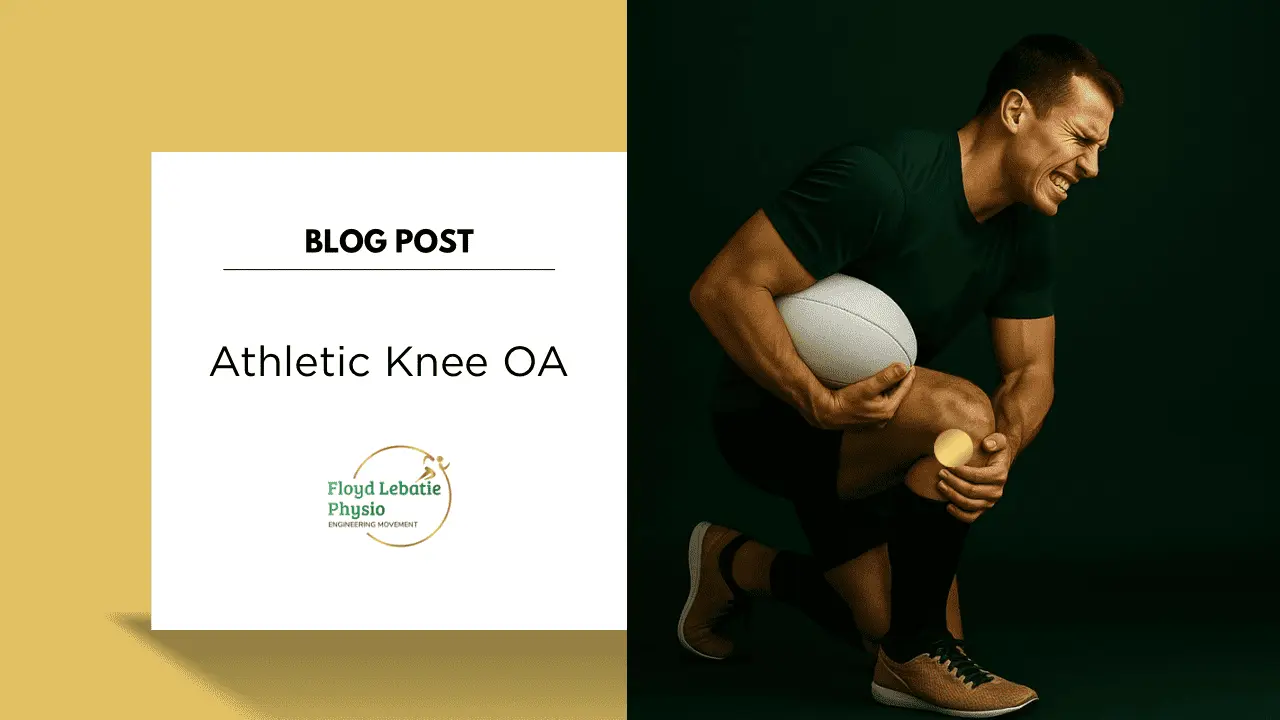Athletic Knee Osteoarthritis: It’s just knee pain, right?
Knee pain is common in athletes – but when it lingers, it might be more than just overuse.
Athletic Knee Osteoarthritis (OA) is different from typical age-related OA. It often affects younger, active people due to repetitive stress, high-impact sports, or previous injuries.
This blog answers the most common questions athletes have about knee OA, treatment, and returning to sport.
What is athletic knee osteoarthritis?
Osteoarthritis (OA) is a condition where the cartilage in your joints – the smooth tissue that cushions bones – gradually wears down.
In athletes, OA often develops earlier than in the general population due to:
- Repetitive loading on the knees.
- Previous injuries (e.g. ACL tears, meniscus damage).
- High-impact sports (e.g. football, rugby, basketball, long-distance running).
Unlike “normal” OA, which usually appears later in life, athletic OA can start in your 20s, 30s, or 40s.
How common is knee OA in athletes?
- General population: ~7.3%
- Athletes: ~7.7% overall – but much higher in certain sports.
- High-risk sports:
- Football & rugby
- Wrestling
- Long-distance running
- Weightlifting
- Basketball & pivot-heavy sports.
What causes OA in athletes?How do meniscus injuries happen?
Athletic knee OA usually develops due to a combination of factors:
- Repetitive overloading: wearing down cartilage faster than it can repair.
- Inflammation: after injury, chemicals in the joint trigger cartilage breakdown.
- Previous knee injuries: ACL tears, meniscus injuries, or fractures increase OA risk.
- Biomechanical stress: poor movement patterns, muscle imbalances, or malalignment.
- High training loads without enough recovery time.
What are the symptoms?
Athletes often ignore early warning signs and push through pain. Watch out for:
- Knee pain during or after activity.
- Stiffness, especially after rest.
- Swelling or mild fluid build-up.
- Clicking, grinding, or creaking in the knee.
- Reduced range of motion.
- Weakness in the quadriceps.
- Changes in gait – limping or avoiding full weight-bearing.
Early OA symptoms can mimic other injuries like patellar tendinopathy or meniscus tears, so proper assessment is essential.
How is athletic knee OA diagnosed?
Your clinician may use a combination of:
- Physical examination: joint tenderness, crepitus, reduced range of motion, swelling.
- X-rays or MRIs.
- Movement analysis: assessing gait and biomechanics to detect abnormal loading patterns using our OptoGait technology and balance deficits using our Kinetisense technology.
How is athletic knee OA treated?
Treatment focuses on managing symptoms, preserving function, and delaying progression.
A. Non-Surgical (First-Line) Management
Evidence-based and recommended for most athletes
- Exercise therapy (the cornerstone of treatment)
- Strengthen: quadriceps, glutes, hip adductors, and core.
- Improve flexibility and mobility.
- Include low-impact cardio: cycling, swimming, or aqua therapy.
- Proprioception and balance drills for joint stability.
- Load management
- Modify training to reduce repetitive stress.
- Avoid prolonged high-impact or pivot-heavy activities during flare-ups.
- We use our LightSpeed Lift and OptoGait technology to aid with load management and gait retraining, especially when working on return to running.
- We keep track of your strength and power output using our handheld dynamometry and OptoGait technology.
- Pain relief strategies
- Ice, topical NSAIDs, and activity pacing.
- Bracing or supportive taping if needed.
- Education
- Understand OA as a manageable condition.
- Set realistic goals: focus on function, not necessarily “curing” OA.
- Exercise therapy (the cornerstone of treatment)
B. Surgical Options
Surgery is not the first choice but may be considered when:
- Pain severely limits activity or daily function.
- Conservative rehab hasn’t worked after 6+ months.
- There is significant structural damage.
Options include:
- Arthroscopy (less common today – limited benefit for OA).
- Cartilage repair techniques in younger athletes.
- Total knee replacement (TKR) – generally reserved for severe cases.
In cases that may require surgical intervention, we work very closely with surgeons to determine whether or not surgery is needed or if going the conservative route would be best. These cases are based on the needs and severity of symptoms of the individual.
Everybody’s road to recovery looks different, which is why we tailor rehabilitation programs to you according to your needs and demands of physical activity.
Can athletes return to sport after knee OA?
Yes – but how and when depends on your treatment and sport.
Return-to-Sport Checklist:
Before returning, you should have:
- Full, pain-free range of motion.
- At least 90% strength compared to your uninjured side.
- Restored balance and proprioception.
- No swelling or mechanical symptoms.
- Ability to complete sport-specific drills without discomfort.
- Ensuring that your strength metrics are optimised. Meaning that your quads produce a force (Newtons) that is 6x your body weight, your hamstrings produce a force that is 4x your body weight, and your glute and groin produce a force that equal to 3.4x body weight in newtons.
Can OA be prevented or delayed?
While you can’t always prevent OA, you can reduce your risk:
- Avoid overtraining – allow enough rest between sessions.
- Strengthen hip, glute, and core muscles to reduce knee stress.
- Correct movement mechanics with the help of a physiotherapist.
- Manage body weight to reduce joint loading.
- Seek early treatment from your physiotherapists for injuries like ACL or meniscus tears to minimise long-term damage.
What about new treatments like PRP or stem cells?
Biologic therapies, such as platelet-rich plasma (PRP) and stem cell injections, are being explored for early OA.
Current evidence suggests:
- Some short-term symptom relief.
- Long-term benefits are still uncertain.
- Should be considered adjuncts, not replacements, for exercise-based rehab.
The best treatment is still exercise based rehab. It is important to note that we tailor programs to individuals and do not use generic programs to treat conditions. This means that your program is highly individualised and designed to address YOUR deficits to get you back to peak performance.
Key Takeaways:
- Athletes are at higher risk of knee OA, especially after previous injuries or years of high-impact training.
- Exercise and physiotherapy are the most effective, evidence-based treatments.
- Surgery is reserved for severe cases or failed conservative care.
- With the right management, returning to sport is possible — but often with modifications.
- We treat the person, not the condition. This means that each treatment plan as well as rehabilitation is tailored to the individual. It is very important to do exercises prescribed by your physio to keep you safe and prevent further injury.
- Early intervention is key to maintaining knee health and performance.
Bottom Line:
Athletic knee OA doesn’t mean the end of your sporting career.
With the right diagnosis, personalised rehab, and smart load management, you can stay active, delay progression, and return to the activities you love.


